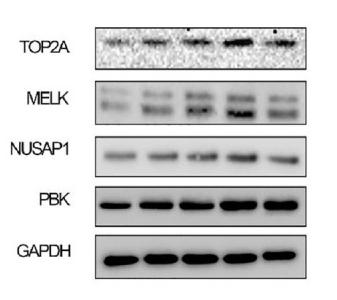MELK Antibody - #DF3278
| Product: | MELK Antibody |
| Catalog: | DF3278 |
| Description: | Rabbit polyclonal antibody to MELK |
| Application: | WB IF/ICC |
| Cited expt.: | WB |
| Reactivity: | Human |
| Mol.Wt.: | 75 KD; 75kD(Calculated). |
| Uniprot: | Q14680 |
| RRID: | AB_2835646 |
Related Downloads
Protocols
Product Info
*The optimal dilutions should be determined by the end user. For optimal experimental results, antibody reuse is not recommended.
*Tips:
WB: For western blot detection of denatured protein samples. IHC: For immunohistochemical detection of paraffin sections (IHC-p) or frozen sections (IHC-f) of tissue samples. IF/ICC: For immunofluorescence detection of cell samples. ELISA(peptide): For ELISA detection of antigenic peptide.
Cite Format: Affinity Biosciences Cat# DF3278, RRID:AB_2835646.
Fold/Unfold
AI327312; hMELK; HPK 38; hPK38; KIAA0175; Likely ortholog of maternal embryonic leucine zipper kinase; Maternal embryonic leucine zipper kinase; MELK; MELK_HUMAN; mKIAA0175; MPK38; OTTHUMP00000021377; OTTHUMP00000046113; pEg3 kinase; Protein kinase Eg3; Protein kinase PK38; RP23 382O11.1; Tyrosine protein kinase MELK;
Immunogens
A synthesized peptide derived from human MELK, corresponding to a region within the internal amino acids.
- Q14680 MELK_HUMAN:
- Protein BLAST With
- NCBI/
- ExPASy/
- Uniprot
MKDYDELLKYYELHETIGTGGFAKVKLACHILTGEMVAIKIMDKNTLGSDLPRIKTEIEALKNLRHQHICQLYHVLETANKIFMVLEYCPGGELFDYIISQDRLSEEETRVVFRQIVSAVAYVHSQGYAHRDLKPENLLFDEYHKLKLIDFGLCAKPKGNKDYHLQTCCGSLAYAAPELIQGKSYLGSEADVWSMGILLYVLMCGFLPFDDDNVMALYKKIMRGKYDVPKWLSPSSILLLQQMLQVDPKKRISMKNLLNHPWIMQDYNYPVEWQSKNPFIHLDDDCVTELSVHHRNNRQTMEDLISLWQYDHLTATYLLLLAKKARGKPVRLRLSSFSCGQASATPFTDIKSNNWSLEDVTASDKNYVAGLIDYDWCEDDLSTGAATPRTSQFTKYWTESNGVESKSLTPALCRTPANKLKNKENVYTPKSAVKNEEYFMFPEPKTPVNKNQHKREILTTPNRYTTPSKARNQCLKETPIKIPVNSTGTDKLMTGVISPERRCRSVELDLNQAHMEETPKRKGAKVFGSLERGLDKVITVLTRSKRKGSARDGPRRLKLHYNVTTTRLVNPDQLLNEIMSILPKKHVDFVQKGYTLKCQTQSDFGKVTMQFELEVCQLQKPDVVGIRRQRLKGDAWVYKRLVEDILSSCKV
Research Backgrounds
Serine/threonine-protein kinase involved in various processes such as cell cycle regulation, self-renewal of stem cells, apoptosis and splicing regulation. Has a broad substrate specificity; phosphorylates BCL2L14, CDC25B, MAP3K5/ASK1 and ZNF622. Acts as an activator of apoptosis by phosphorylating and activating MAP3K5/ASK1. Acts as a regulator of cell cycle, notably by mediating phosphorylation of CDC25B, promoting localization of CDC25B to the centrosome and the spindle poles during mitosis. Plays a key role in cell proliferation and carcinogenesis. Required for proliferation of embryonic and postnatal multipotent neural progenitors. Phosphorylates and inhibits BCL2L14, possibly leading to affect mammary carcinogenesis by mediating inhibition of the pro-apoptotic function of BCL2L14. Also involved in the inhibition of spliceosome assembly during mitosis by phosphorylating ZNF622, thereby contributing to its redirection to the nucleus. May also play a role in primitive hematopoiesis.
Autophosphorylated: autophosphorylation of the T-loop at Thr-167 and Ser-171 is required for activation. Thr-478 phosphorylation during mitosis promotes interaction with PPP1R8 (Probable).
Cell membrane>Peripheral membrane protein.
Expressed in placenta, kidney, thymus, testis, ovary and intestine.
The KA1 domain mediates binding to phospholipids and targeting to membranes.
Belongs to the protein kinase superfamily. CAMK Ser/Thr protein kinase family. SNF1 subfamily.
References
Application: WB Species: Human Sample: breast cancer tissue
Restrictive clause
Affinity Biosciences tests all products strictly. Citations are provided as a resource for additional applications that have not been validated by Affinity Biosciences. Please choose the appropriate format for each application and consult Materials and Methods sections for additional details about the use of any product in these publications.
For Research Use Only.
Not for use in diagnostic or therapeutic procedures. Not for resale. Not for distribution without written consent. Affinity Biosciences will not be held responsible for patent infringement or other violations that may occur with the use of our products. Affinity Biosciences, Affinity Biosciences Logo and all other trademarks are the property of Affinity Biosciences LTD.


